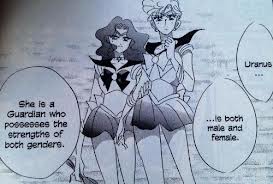 Gurren Lagann is one of those anime series I’ve long heard praised so, I decided it was high time I found about for myself what all the fuss was about. The series takes place in a world where humans have moved underground to flee the Spiral King and the “beastmen” who use machines to wipe humans off the earth. Thus, the humans secluded themselves into small villages with no contact with the surface or other humans. Simon, a small, unimposing young man who spends most his time digging, and his outspoken, reckless friend, Kamina dream of leaving their dank village underground and going to the surface. One day, after Simon comes across a strange object that turns out to be a key to a machine like those the beastmen use. After a girl (Yoko) fighting a beastman falls from the surface into their village, Simon and Kamina use the newly-found machine to defeat the beastman and break through to the surface. Together with Yoko, they begin to wage war against the beastmen.
Gurren Lagann is one of those anime series I’ve long heard praised so, I decided it was high time I found about for myself what all the fuss was about. The series takes place in a world where humans have moved underground to flee the Spiral King and the “beastmen” who use machines to wipe humans off the earth. Thus, the humans secluded themselves into small villages with no contact with the surface or other humans. Simon, a small, unimposing young man who spends most his time digging, and his outspoken, reckless friend, Kamina dream of leaving their dank village underground and going to the surface. One day, after Simon comes across a strange object that turns out to be a key to a machine like those the beastmen use. After a girl (Yoko) fighting a beastman falls from the surface into their village, Simon and Kamina use the newly-found machine to defeat the beastman and break through to the surface. Together with Yoko, they begin to wage war against the beastmen.
While Gurren Lagann is unique in many ways, at the halfway mark of the second season, I’m feelings a bit disengaged as a female viewer. Of the cast of female characters that have been assembled, almost all of them are heavily subjected to fan service and/or fall victim to the damsel in distress cliche to give the male characters motivation. That’s not to say that the female characters sit on the side lines all the time (Yoko and two side female characters do participate in battles), but somehow I feel the way they are presented undermines them.
For instance, there have been two episodes that either had good portions or the full episode devoted to fan service. One takes place at a hot spring and involves Kamina and Simon trying to figure out how to catch a peek of the girls naked. Later, the girls are held hostage dressed in towels, reducing them to not only sex objects, but sex objects that need rescuing. The other episode involves bathing suits. Need I say more? The guys drool over the girls since it’s a chance to see them less covered. Yoko, who is usually in little more than a bikini top and short-shorts, actually wears a bathing suit that covers her more than usual and is disregarded as a result. To be fair, the show mixes in a fair amount of zaniness, which these episodes were playing up, but by focusing so much on the female characters’ bodies, it reduces them to fan fare.
 As the two main female protagonists, Yoko and Nia, both suffer from female character clichés. Yoko is no helpless maiden. She’s been fighting the enemy for some time now in what seemed to be a losing battle. Once Simon and Kamina join the fight, new life is breathed into the resistance. At that point, Yoko could have just relied totally on the guys from then on, but she doesn’t. She is put into more of a supporting role, but she’s good at watching her comrades’ backs. Unfortunately, Yoko’s strengths, both inner and outer, take a back seat to her exterior appearance. For some reason, this character who’s fighting a war dresses in a bikini top that’s slightly too small for her and short shorts. Viewers are constantly getting shots of Yoko’s breasts, even when she’s in battle, taking a shot at the enemy, the view is such that we (conveniently) get to see her boobs bounce from the kick-back of her gun. Thus, Yoko largely gets reduced to eye candy.
As the two main female protagonists, Yoko and Nia, both suffer from female character clichés. Yoko is no helpless maiden. She’s been fighting the enemy for some time now in what seemed to be a losing battle. Once Simon and Kamina join the fight, new life is breathed into the resistance. At that point, Yoko could have just relied totally on the guys from then on, but she doesn’t. She is put into more of a supporting role, but she’s good at watching her comrades’ backs. Unfortunately, Yoko’s strengths, both inner and outer, take a back seat to her exterior appearance. For some reason, this character who’s fighting a war dresses in a bikini top that’s slightly too small for her and short shorts. Viewers are constantly getting shots of Yoko’s breasts, even when she’s in battle, taking a shot at the enemy, the view is such that we (conveniently) get to see her boobs bounce from the kick-back of her gun. Thus, Yoko largely gets reduced to eye candy.
On the other hand, Nia is more traditional, playing the part of the girl with inner strength that relies on the male protagonist. Don’t get me wrong; a female character doesn’t have to shoot a gun or punch people to be strong. In fact, if she can pick up a gun, but has nothing beyond that, I’m not sure I could call her a strong female character. There’s something to be admired in characters like Nia who show such inner strength. Nia has been abandoned by the people she knew and her own father. She’s told she was little more than a pretty doll to him, something to be admired for its beauty and discarded when one grows tired of it, and she has been thrust out into a world she knows very little about as being sheltered for so long. Her whole world has been turned upside down yet she has the strength to assess the situation and make her own decisions. The problem occurs here: whenever Nia is in trouble, she’s not worried in the least, not because she has a plan to save herself as I initially thought, but because she has such strong faith that Simon will rescue her and anyone else in trouble. It’s nice that she has such faith in Simon–one of the first besides Kamina to recognize it–but that total reliance, or rather dependence, and expectation that someone will come to her aid is pretty cliché.
initially thought, but because she has such strong faith that Simon will rescue her and anyone else in trouble. It’s nice that she has such faith in Simon–one of the first besides Kamina to recognize it–but that total reliance, or rather dependence, and expectation that someone will come to her aid is pretty cliché.
As I watch Gurren Lagann I do see hope for its female protagonists. While I’m not sure it will ever be excellent in terms of female characters given the way the show has treated them so much as fan service, I’m hoping for more development to take these characters to the next level. I’ll keep my fingers crossed.


